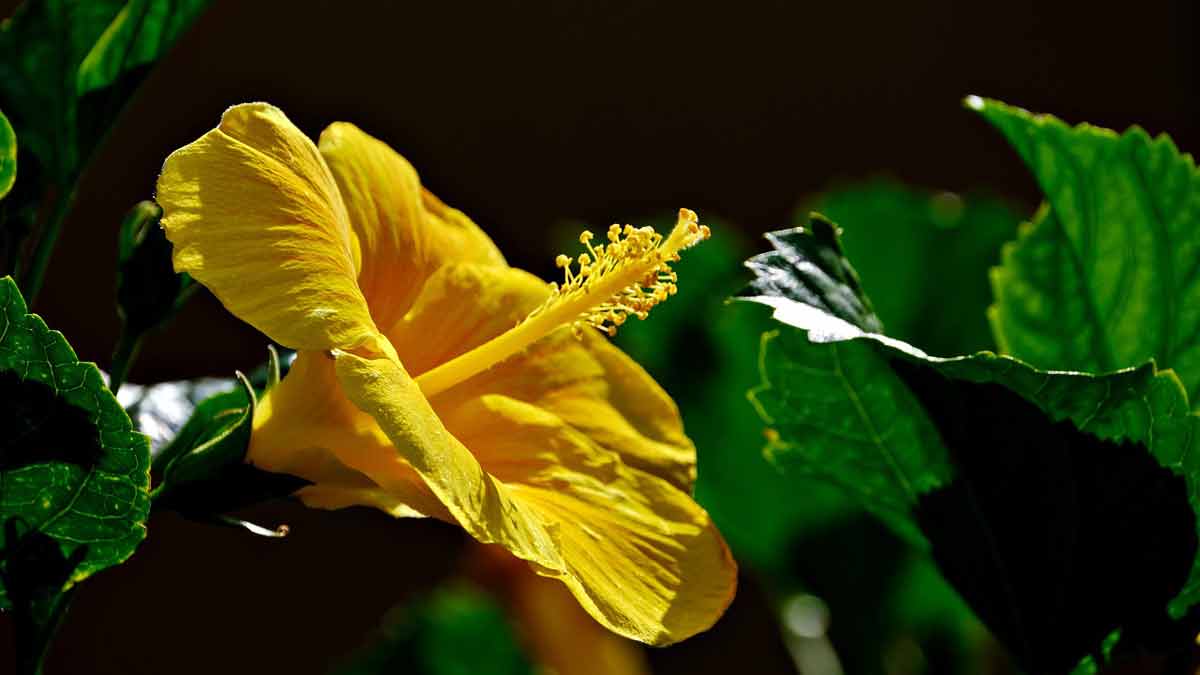Hibiscus plants are beautiful, vibrant, and relatively easy to care for.
However, they can still experience problems sometimes, especially if they’re not cared for properly.
One of the most common issues is drooping leaves.
There are several reasons why hibiscus leaves might droop, but fortunately, there are several solutions.
In this article, we’ll discuss seven possible causes of drooping hibiscus leaves and what you can do to fix the problem.
Why Are My Hibiscus Leaves Drooping and How Can You Fix It?
Hibiscus plants are typically quite hardy.
However, several things can cause the leaves on your hibiscus to droop.
Here are the most common causes for why your hibiscus leaves might be drooping, along with some solutions.
1. Not Enough Water
Hibiscus plants need to be watered regularly, especially during hot weather.
If the leaves on your hibiscus plant are drooping, it might indicate that the plant is not getting enough water.
When the hibiscus is underwatered, the plant cannot take up enough water to support the leaves, causing them to droop.
How To Tell If Your Hibiscus Is Underwatered
There are a few ways to tell if your hibiscus is underwatered.
First, check the soil.
The plant needs to be watered if it feels dry to the touch.
Common signs of an underwatered hibiscus include:
- Wilting leaves
- Yellow leaves
- Dry, brittle leaves
How To Fix An Underwatered Hibiscus
If you think your hibiscus is underwatered, the first step is to check the soil.
If it is dry, water the plant immediately.
Be sure to water deeply so that the water reaches the roots.
If the soil is still dry after watering, you may need to water more frequently.
2. Too Much Water
While hibiscus plants need to be watered regularly, it is possible to overwater them.
Overwatering usually happens when the plant is getting too much water too often.
The soil around the hibiscus becomes saturated and can’t drain properly.
This can cause the roots to rot, eventually killing the plant.
How To Tell If Your Hibiscus Is Overwatered
There are a few signs that your hibiscus plant is overwatered.
First, check the soil.
The plant is getting too much water if it is soggy or wet.
Other signs of overwatering include:
- Yellow leaves
- Leaves that are falling off
- Mushy stems
- Root rot
- Fungus or mold growing on the plant
How To Fix An Overwatered Hibiscus
If you think your hibiscus is overwatered, the first step is to check the soil.
If it is soggy, stop watering the plant immediately.
Next, allow the soil to dry out completely before watering again.
If the plant is still showing signs of overwatering, you may need to repot it in a dryer, well-draining soil.
3. Temperature Stress
Another common reason for hibiscus leaves drooping is temperature stress.
Your hibiscus prefers warm weather and sunny days.
However, if the temperature gets too high or too low, your plant will start to experience stress.
Sudden temperature changes are especially troublesome for hibiscus plants.
How To Tell If Your Hibiscus Is Stressed by Temperature
There are a few signs that your hibiscus is stressed by temperature.
If the leaves are drooping or wilting, that is usually a sign that the plant is too cold.
On the other hand, if the hibiscus leaves are turning yellow or curling, that is usually a sign that the plant is too hot.
Other signs of temperature stress include:
- Yellow leaves
- Leaves that are falling off
- Buds that fall off before they bloom
- Slow growth
How To Fix A Hibiscus Stressed by Temperature
If you think your hibiscus plant is stressed by temperature, the first step is to check the temperature.
If it is too hot or too cold, try to move the plant to a more moderate temperature.
Hibiscus plants thrive in temperatures that are between 65 and 85 degrees Fahrenheit.
You need to be especially careful of sudden temperature changes, as they can be very stressful for hibiscus plants.
Place your plant in a spot that is away from drafts, heaters, and air conditioners.
4. Low Humidity
Hibiscus plants prefer moderate to high humidity levels.
If the air around your hibiscus is too dry, the plant will start to experience stress.
When the humidity is too low, the leaves will start to lose moisture.
This can cause the leaves to droop and wilt.
How To Tell If The Air Around Your Hibiscus Is Too Dry
There are a few signs that the air around your hibiscus is too dry.
If the leaves are drooping or wilting, that is usually a sign that the air is too dry.
Other signs of low humidity include:
- Dry, brittle leaves
- Leaves that are turning brown or yellow
- Flowers that are falling off before they open
- Wilting flowers
How To Fix A Hibiscus Stressed by Low Humidity
If you think the air around your hibiscus is too dry, the first step is to increase the humidity.
You can do this by misting the plant regularly or placing it on a pebble tray.
Misting the plant will help to increase the humidity around the plant.
You can also place the plant on a tray of pebbles and water.
The water will evaporate and help to increase the humidity around the plant.
5. Pests
Pests are another common reason for hibiscus leaves drooping.
There are a variety of pests that can attack hibiscus plants, including aphids, mealybugs, and scale insects.
These pests will suck the sap out of the plant, causing the leaves to droop and wilt.
They can also cause the leaves to turn yellow or brown.
Pests can also spread diseases to hibiscus plants.
How To Tell If Your Hibiscus Has Pests
There are a few signs that your hibiscus has pests.
If you see any insects on the plant, that is a sign that there are pests.
Other signs of pests include:
- Sticky leaves
- Holes in the leaves
- Yellow or brown leaves
- Wilting leaves
How To Treat A Hibiscus Plant With Pests
If you think your hibiscus has pests, the first step is to isolate the plant.
This will prevent the pests from spreading to other plants.
You can remove the pests by hand using a cotton swab dipped in rubbing alcohol.
You can also use a natural pest control method, such as neem oil or insecticidal soap.
These methods will kill the pests without harming the plant.
6. Not Enough Sunlight
Hibiscus plants are tropical plants that love the sun.
If your hibiscus isn’t getting enough sunlight, its leaves will start to droop.
Light requirements vary depending on the type of hibiscus, but most prefer at least six hours of sunlight a day.
How To Tell If Your Hibiscus Isn’t Getting Enough Sunlight
There are a few signs that your hibiscus isn’t getting enough sunlight.
If the leaves are drooping or wilting, that is usually a sign that the plant isn’t getting enough sunlight.
Other signs of low sunlight include:
- The leaves are pale in color
- The plant is not growing as quickly as it should be
- Flowers are small or few in number
- The plant is overall stunted in growth
- The plant is leggy (long, thin stems)
How To Fix A Hibiscus That Isn’t Getting Enough Sunlight
If you think your hibiscus isn’t getting enough sunlight, the first step is to move it to a spot that gets more sunlight.
The best spot for your hibiscus is in a south-facing window. This will give the plant the most sunlight possible.
If you can’t move the plant, you can also try using grow lights.
Grow lights will give your hibiscus the extra light it needs to thrive.
7. Transplant Shock
Transplant shock is another common reason for hibiscus leaves drooping.
This usually happens when a plant is moved from one location to another.
The plant’s roots are disturbed, and it takes time to adjust to its new environment.
Transplant shock can also happen if the plant is moved from a pot to the ground or vice versa.
How To Tell If Your Hibiscus Is In Shock
There are a few signs that your hibiscus is in shock.
If the leaves are drooping or wilting, that is usually a sign that the plant is in shock.
Other signs of transplant shock include:
- The leaves turning yellow or brown
- The leaves falling off
- The plant is not growing
- Flowers falling off the plant
How To Fix A Hibiscus In Shock
If you think your hibiscus is in shock, the first step is to water it well.
Watering will help the plant recover from the stress of being transplanted.
You should also ensure that the plant is in a spot with enough sunlight.
Transplant shock usually lasts for a few weeks.
After a few weeks, the plant should start to recover and grow new leaves.
How To Prevent Hibiscus Leaves Drooping
To prevent hibiscus leaves from drooping, here are some tips:
- Water your hibiscus regularly and evenly. The soil should be moist but not soggy. Avoid letting the soil dry out completely between waterings.
- Hibiscus plants like to be in an environment with high humidity. The leaves may droop if the air around your hibiscus is too dry. Try regularly grouping your hibiscus with other plants, running a humidifier, or periodically misting the leaves.
- Make sure your hibiscus is getting enough light. If the leaves are drooping and the stems are stretching, this is a sign that the plant is not getting enough light. Move it to a brighter spot.
- Fertilize your hibiscus monthly during the growing season (spring and summer) with a balanced fertilizer.
- Prune your hibiscus regularly to encourage new growth.
- Avoid placing your hibiscus in drafty areas or near heat sources, as this can cause the leaves to droop.
- Inspect your hibiscus for pests regularly and treat them as needed. Common pests include aphids, mealybugs, and spider mites.
- Keep the leaves of your hibiscus clean by wiping them down with a damp cloth or spraying them with water from a hose.
- Check the potting soil around your hibiscus regularly. If it is compacted, aerate it or add more organic matter to loosen it up.
- If you live in an area with cold winters, bring your hibiscus indoors or protect it with a frost cloth when the temperature drops.
If you follow these tips, you should be able to prevent your hibiscus leaves from drooping.
Final Thoughts
Hibiscus are popular flowering plants that are known for their large, colorful blooms.
However, sometimes the leaves of a hibiscus plant will droop.
If your hibiscus leaves are drooping, it could be due to various reasons, including too much or too little water, not enough light, or pests.
By taking a closer look at the plant and its leaves, you can determine the cause of the problem and take steps to correct it.
Your hibiscus should soon return to its beautiful, blooming self with proper care.







